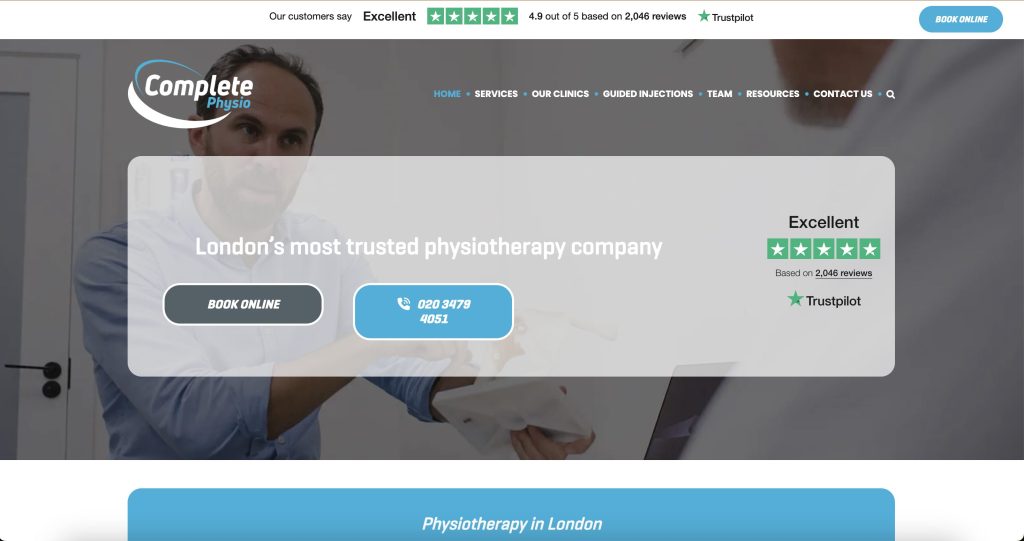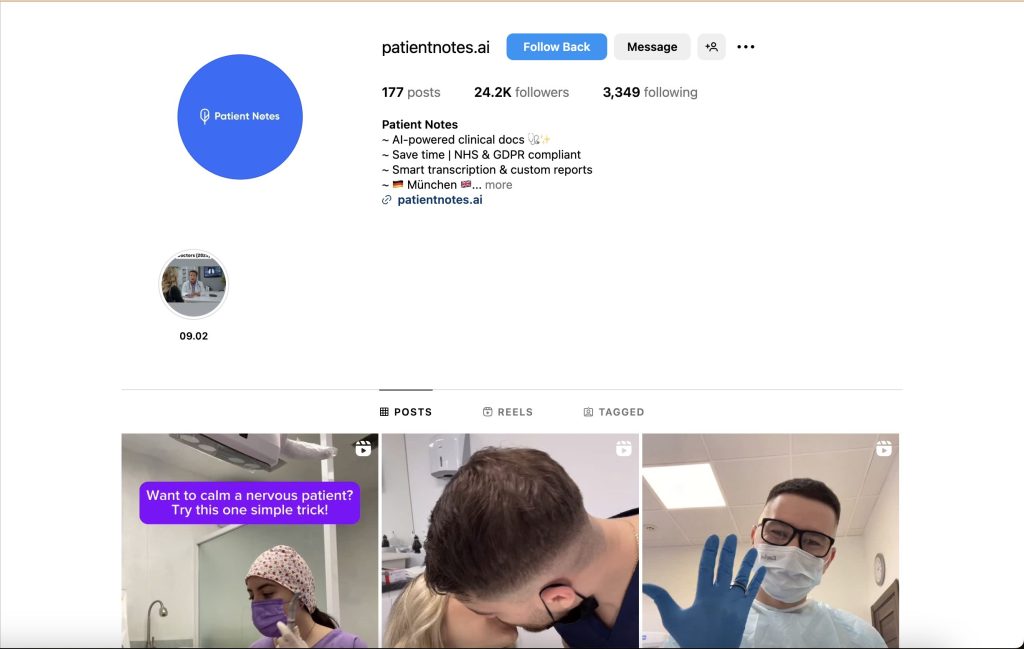In today’s digital-first healthcare landscape, attracting physiotherapy patients requires a strategic online presence. Gone are the days when word-of-mouth alone could fill your appointment book. Instead, potential patients now research their options online before making healthcare decisions, which means your digital strategy directly impacts your practice’s growth.
As a physiotherapist in 2025, you need effective digital marketing approaches that connect with patients seeking your specific services. Fortunately, several proven strategies can help you build visibility, establish credibility, and ultimately convert online visitors into loyal patients.
This guide explores nine actionable techniques to attract more physiotherapy patients through digital channels, helping your practice thrive in an increasingly competitive marketplace.
Why Traditional Patient Acquisition Methods Are No Longer Sufficient
Traditional methods of attracting patients—such as physician referrals and print advertising—while still valuable, are no longer adequate on their own. Research indicates that over 70% of patients now begin their healthcare journey with an online search. Therefore, if your practice lacks a strong digital presence, you’re potentially missing out on a significant portion of prospective patients.
Moreover, the COVID-19 pandemic permanently shifted patient behaviour, with many now preferring to thoroughly research healthcare providers online before making appointments. This shift has transformed digital marketing from a supplementary tactic to an essential component of practice growth.
1. Develop a Patient-Focused Website That Converts
Your website serves as the digital hub for your physiotherapy practice, often providing the first impression for potential patients. However, simply having a website isn’t enough—it must effectively convert visitors into patients.
Essential Website Elements for Patient Conversion
A high-performing physiotherapy website typically includes:
- Intuitive navigation: Visitors should easily find information about your services, team, and booking options without frustration.
- Mobile optimisation: With over 60% of healthcare searches occurring on mobile devices, your site must function flawlessly across all screen sizes.
- Prominent booking options: Make scheduling appointments straightforward through visible buttons and multiple contact methods.
- Clear service descriptions: Detail your specialisations, treatment approaches, and expected outcomes in accessible language.
- Credibility indicators: Feature qualifications, professional memberships, and authentic patient testimonials.
- Location information: Include your address, embedded maps, parking details, and accessibility features.

Optimising the Patient Journey
Your website should guide potential patients through a logical journey from awareness to booking. For instance, someone searching for “shoulder pain relief” might first land on your educational content about shoulder conditions. From there, they should discover your specific treatment approaches, followed by clear calls-to-action for booking an assessment.
Furthermore, implementing live chat can address immediate questions, while offering downloadable resources (such as exercise guides) in exchange for email addresses builds your marketing database.
2. Master Local SEO to Appear in Relevant Searches
When potential patients search for physiotherapy services, they typically include location-specific terms (e.g., “physiotherapist in Manchester”). Therefore, local search engine optimisation (SEO) is crucial for ensuring your practice appears in these results.
Google Business Profile Optimisation
Your Google Business Profile (formerly Google My Business) significantly impacts local search visibility. To optimise this valuable asset:
- Verify your listing and ensure all information is accurate and complete
- Add high-quality photos of your clinic, team, and treatment rooms
- Obtain and respond thoughtfully to patient reviews
- Post regular updates about services, team news, and helpful tips
- Include relevant categories and attributes about your practice
Local Content Development
Creating location-specific content further enhances your visibility in local searches. Consider developing:
- Area-specific landing pages if you serve multiple locations
- Blog posts addressing local health concerns or events
- Community involvement stories highlighting your local presence
- Neighbourhood guides for patients visiting your clinic
Additionally, building citations (mentions of your practice name, address, and phone number) across relevant directories strengthens your local search presence.
3. Leverage Social Media Strategically
Social media platforms offer excellent opportunities to showcase your expertise, build patient relationships, and attract new patients. However, success requires a strategic approach rather than posting sporadically.
Platform Selection and Content Strategy
Different platforms serve different purposes for physiotherapy practices:
- Facebook: Ideal for community building, patient education, and event promotion
- Instagram: Perfect for visual content showing exercises, clinic facilities, and team culture
- LinkedIn: Valuable for professional networking and B2B referral development
- YouTube: Excellent for educational videos and exercise demonstrations

Each platform requires tailored content, though some common effective formats include:
- Patient success stories (with proper consent)
- Exercise demonstrations and technique tips
- Condition-specific educational content
- Behind-the-scenes glimpses of your practice
- Team introductions and expertise highlights
Building Engagement and Community
Simply posting content isn’t enough—engagement is crucial. Successful practices actively respond to comments and messages, participate in relevant discussions, and create opportunities for interaction. For example, hosting occasional Q&A sessions or live discussions about common conditions can significantly boost engagement.
Nevertheless, consistency remains key to social media success. Even limited but regular posting typically outperforms sporadic activity, regardless of content quality.
4. Implement Pay-Per-Click Advertising for Immediate Visibility
While organic strategies build long-term success, pay-per-click (PPC) advertising delivers immediate visibility to potential patients actively seeking physiotherapy services.
Strategic Keyword Targeting
Effective PPC campaigns focus on keywords with high intent, such as:
- “Physiotherapist near me”
- “Back pain treatment [location]”
- “Sports injury physiotherapy”
- “Private physiotherapy assessment”
These searches indicate someone actively seeking treatment rather than just researching a condition. Consequently, they typically yield higher conversion rates despite potentially higher costs per click.
Optimising Campaigns for Conversion
To maximise return on investment (ROI) from PPC campaigns:
- Create dedicated landing pages for each campaign focus
- Include location targeting to reach patients within your service area
- Implement call extensions allowing patients to contact you directly from ads
- Utilise remarketing to reconnect with website visitors who didn’t book
- Schedule ads during hours when patients typically search for services
Additionally, tracking conversions helps identify which keywords and ad formats generate actual appointments, allowing continuous refinement of your campaigns.
5. Gather and Showcase Patient Testimonials
Patient testimonials significantly influence decision-making, with studies showing that 88% of consumers trust online reviews as much as personal recommendations. Therefore, systematically collecting and highlighting positive patient experiences can dramatically impact new patient acquisition.
Effective Testimonial Collection
Develop a consistent process for gathering testimonials by:
- Sending follow-up emails after treatment completion
- Creating simple feedback forms accessible via QR codes in your clinic
- Training staff to politely request reviews from satisfied patients
- Offering small incentives for completing feedback (while complying with healthcare regulations)
Strategic Testimonial Placement
Once collected, testimonials should be strategically placed throughout your digital presence:
- Featured prominently on your website homepage
- Included on specific service pages related to the testimonial content
- Shared occasionally on social media (with patient permission)
- Incorporated into email marketing campaigns
- Highlighted in Google Business Profile updates
Moreover, video testimonials can be particularly powerful, as they add authenticity and emotional connection that text alone cannot achieve.
6. Create Valuable Educational Content
Educational content establishes your expertise while attracting potential patients searching for information about their conditions. Additionally, regular content creation improves your search visibility and provides shareable material for social media.
Content Types for Patient Attraction
Effective educational content for physiotherapy practices includes:
- Blog articles explaining common conditions and treatment approaches
- Downloadable guides for condition management or prevention
- Video demonstrations of therapeutic exercises
- Infographics explaining complex concepts or procedures
- FAQs addressing common patient concerns
Content Distribution Strategies
Creating content is only half the battle—distribution ensures it reaches your target audience:
- Share across appropriate social media platforms
- Include in email newsletters to current and past patients
- Repurpose into different formats (e.g., turn blog posts into videos)
- Consider guest posting on relevant healthcare websites
- Develop relationships with local media for expert commentary opportunities
Above all, focus on addressing genuine patient questions and concerns rather than creating content solely for search engines.
7. Utilise Email Marketing for Patient Nurturing
Email marketing delivers exceptional ROI for physiotherapy practices, enabling you to nurture relationships with potential patients and re-engage past patients effectively.
Building Your Email List
Grow your email database through:
- Website sign-up forms offering valuable resources
- In-clinic collection with clear permission
- Special event registrations
- Social media promotion of exclusive content
Email Campaign Types
Different email approaches serve various objectives:
- Welcome sequences introducing new subscribers to your practice
- Educational newsletters sharing healthcare tips and clinic updates
- Targeted campaigns for specific conditions or treatments
- Re-engagement emails for past patients due for check-ups
- Seasonal campaigns addressing timely health concerns
Meanwhile, personalisation significantly improves engagement rates. Consider segmenting your list based on conditions treated, treatment stage, or how patients discovered your practice.
8. Partner with Complementary Health Professionals
Digital referral networks can substantially increase patient flow. Building relationships with complementary health professionals—such as general practitioners, massage therapists, personal trainers, and nutritionists—creates mutually beneficial referral opportunities.
Digital Partnership Strategies
Leverage your online presence to strengthen professional partnerships through:
- Cross-promotion on social media platforms
- Guest blogging on each other’s websites
- Joint webinars or educational events
- Shared digital resources for patients
- Social media mentions and endorsements
Most importantly, ensure these relationships benefit patients by facilitating comprehensive care, rather than focusing solely on business advantages.

9. Monitor Analytics and Refine Your Approach
Data-driven decision-making separates successful digital patient acquisition from wasted marketing efforts. Regular analysis of key metrics helps identify effective strategies and areas for improvement.
Essential Metrics to Track
Focus on these critical indicators:
- Website performance: Traffic sources, page popularity, and conversion rates
- Search visibility: Keyword rankings and Google Business Profile insights
- Social media effectiveness: Engagement rates, follower growth, and referral traffic
- Email campaign performance: Open rates, click-through rates, and conversions
- PPC results: Click-through rates, cost per click, and cost per acquisition
Continuous Improvement Process
Establish a regular review cycle (monthly or quarterly) to analyse performance data and make informed adjustments. Additionally, stay current with digital marketing trends affecting healthcare to maintain competitive advantage.
Implementing Your Strategy: Where to Begin
With numerous potential strategies, determining your starting point may seem overwhelming. Consider beginning with these foundational elements:
- Audit your current online presence to identify strengths and weaknesses
- Ensure your Google Business Profile is fully optimised for immediate local visibility
- Develop or update your website to focus on patient conversion
- Create a basic content calendar for educational material and social media
- Implement analytics tracking to measure results from the outset
Subsequently, expand into additional strategies based on your practice’s specific goals, resources, and target patient demographics.
Common Challenges and Solutions
Physiotherapists typically encounter these obstacles when implementing digital patient acquisition strategies:
- Time constraints: Consider outsourcing specific tasks or using scheduling tools to maintain consistency
- Budget limitations: Start with cost-effective organic strategies before investing in paid advertising
- Content creation difficulties: Develop a system for converting patient questions into content topics
- Compliance concerns: Establish clear policies for patient privacy and testimonial consent
- Technical complexity: Partner with healthcare-specific digital marketing specialists when needed
Conclusion: Building a Sustainable Patient Acquisition System
Attracting physiotherapy patients online requires a comprehensive approach that combines multiple strategies. Through consistent implementation, regular analysis, and strategic refinement, you can build a digital patient acquisition system that continuously brings new patients to your practice.
Remember that digital marketing is not a single campaign but an ongoing process. As a result, even modest but consistent efforts typically yield better results than intermittent, larger initiatives.
By implementing these nine strategies, you’ll not only attract more patients in the short term but also build a sustainable foundation for long-term practice growth.
Key Takeaways
- Develop a patient-focused website that guides visitors toward booking appointments
- Optimise your local SEO presence, especially your Google Business Profile
- Create strategic social media content that educates and engages potential patients
- Use PPC advertising for immediate visibility in competitive markets
- Collect and showcase authentic patient testimonials across digital channels
- Create valuable educational content addressing patient concerns
- Implement email marketing to nurture relationships with potential and past patients
- Build digital referral networks with complementary health professionals
- Regularly analyse performance data to refine your approach
Frequently Asked Questions About Attracting Physiotherapy Patients Online
How quickly can digital marketing strategies start bringing in new physiotherapy patients?
Digital marketing typically works on different timelines depending on the strategy. PPC advertising can bring immediate results, often generating new patient enquiries within days of campaign launch. Social media and email marketing usually show meaningful results within 1-3 months of consistent effort. SEO strategies typically require 3-6 months to significantly impact patient acquisition, but produce more sustainable long-term results. For most physiotherapy practices, a combination of immediate (PPC) and long-term (SEO, content) strategies creates the optimal patient acquisition system.
What types of content are most effective for attracting physiotherapy patients?
The most effective content addresses specific patient pain points and questions. Condition-specific content (e.g., “Managing Lower Back Pain During Pregnancy”) typically outperforms general physiotherapy information. Exercise demonstrations, self-assessment guides, and recovery timeline expectations are particularly valuable to potential patients. Content that combines educational value with clear next steps for seeking professional help tends to convert best. Additionally, content formats should match patient preferences—while some prefer detailed articles, others engage better with video demonstrations or infographics.
How important are online reviews for attracting new physiotherapy patients?
Online reviews are extremely influential in healthcare decisions. Research shows that 91% of patients use online reviews when evaluating new healthcare providers, and 84% trust these reviews as much as personal recommendations. Physiotherapy practices with 4.5+ star ratings typically receive significantly more enquiries than those with lower ratings, regardless of other marketing efforts. The quantity of reviews also matters—practices with 15+ recent reviews appear more established and trustworthy. Additionally, how you respond to reviews (both positive and negative) demonstrates your communication style and patient care approach to prospective patients.
What budget should physiotherapy practices allocate for online patient acquisition?
Effective budgeting depends on practice size, goals, and local competition. As a general guideline, new practices typically need to invest 10-15% of expected annual revenue in marketing, with established practices often allocating 5-10%. For specific digital channels, consider the patient lifetime value in your calculations. For example, if your average patient generates £1,500 in revenue, spending £150-300 to acquire that patient (10-20% of lifetime value) represents a sound investment. Start with foundational elements like website optimisation and Google Business Profile management before expanding into paid advertising. Track cost-per-acquisition for each channel to refine budget allocation over time.
How can physiotherapists measure the ROI of their digital marketing efforts?
Measuring ROI requires tracking the entire patient journey from initial digital touchpoint to completed treatment. Implement these tracking methods: 1) Use UTM parameters in campaign links to identify traffic sources in analytics, 2) Set up conversion tracking for appointment requests on your website, 3) Train reception staff to ask and record how new patients found your practice, 4) Use unique phone numbers for different marketing channels to track call origins, 5) Calculate acquisition cost per channel (total spend divided by new patients), and 6) Compare with average patient value. Most physiotherapy practices find that even basic tracking reveals significant ROI disparities between channels, allowing for more effective budget allocation.
| Digital Strategy | Implementation Difficulty | Time to Results | Cost Level | Recommended For |
|---|---|---|---|---|
| Google Business Profile | Low | 1-4 weeks | Free | All practices (essential) |
| Website Optimisation | Medium-High | 1-3 months | Medium-High | All practices (essential) |
| Local SEO | Medium | 3-6 months | Low-Medium | All practices (essential) |
| Content Marketing | Medium | 3-9 months | Low-Medium | Practices seeking authority building |
| Social Media | Low-Medium | 1-3 months | Low (organic), Medium (paid) | Practices targeting younger demographics |
| Google Ads | Medium-High | Immediate | High | New practices or those needing immediate patients |
| Email Marketing | Low-Medium | 1-3 months | Low | Practices with existing patient database |
| Online Reviews | Low | 1-3 months | Free | All practices (essential) |



